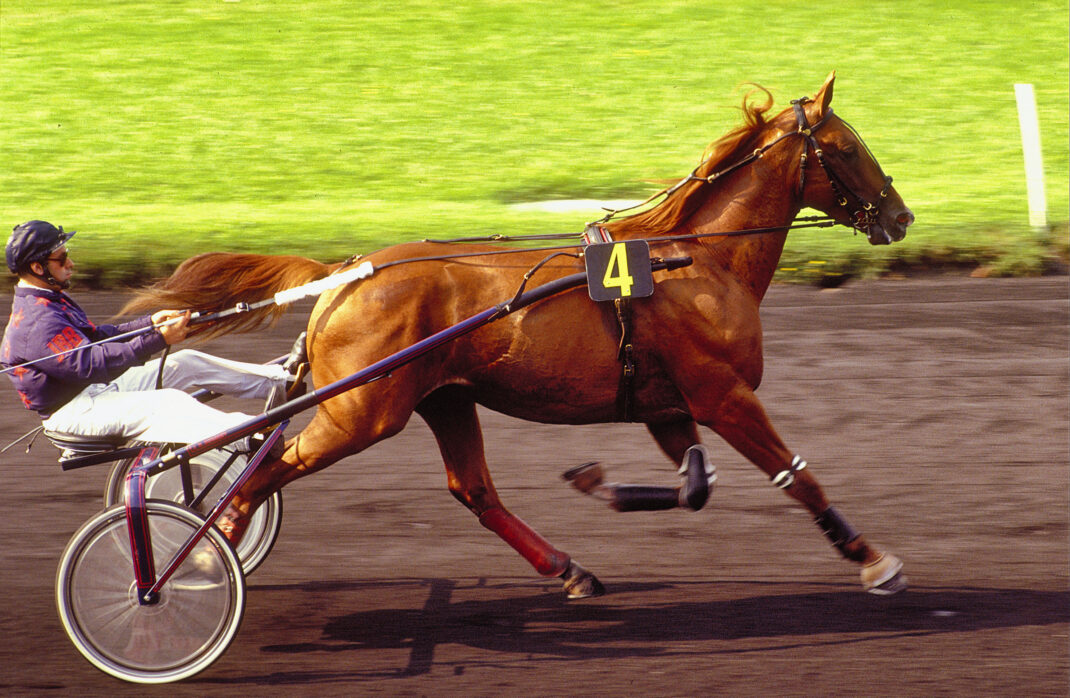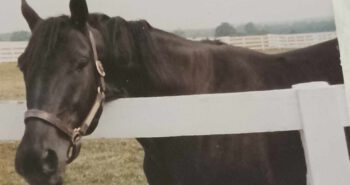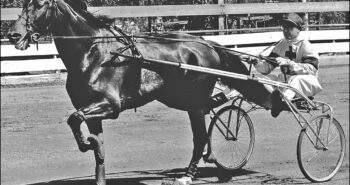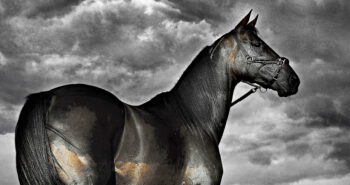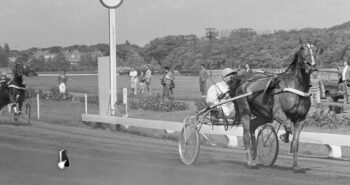When Jean-Baptiste Bossuet looked at the yearling in September 1986, he wasn’t particularly impressed. There just was no “wow” feeling to the chestnut, but breeder Bernard Hallope, keen on selling, offered Bossuet 50 % at a low price if he would start training the horse. Bossuet accepted, somewhat reluctantly, as he knew that many other buyers, including some big-name trainers, had examined the yearling and found him wanting. Could all of them be so wrong? As it turned out, they could.
Breaking him in and then training him carefully – Bossuet isn’t one to rush his youngsters – Tenor de Baune improved steadily but his trainer still didn’t feel any “wow” factor. Hallope didn’t really want to own part of a racehorse and signaled to Bossuet that if he could find a buyer for the remaining half of the horse he was very keen on selling. Close to Christmas 1988, Bossuet persuaded his brother to buy the second half of the 2-year-old horse for a lowly 25,000 francs, less than 4,000 euros. Tenor de Baune was still unstarted but had qualified 3 months earlier. Still, Bossuet thought he had a decent horse, but nothing more, on his hands.
When a trainer believe they have a horse that is among the best in the crop they then to start them almost exclusively in the bigger races at Vincennes. Bossuet refused to believe Tenor de Baune had any business at Vincennes at first and the colt made his career debut with a win at Argentan before starting at the idyllic Meslay-du-Maine racetrack. With hindsight it seems almost ridiculous that Tenor de Baune spent most of his 3-year-old season at provincial, tracks but Bossuet still felt his chestnut tank, though looking relatively good, was nowhere near the required level to take on the best trotters in the 1985-crop. The chestnut colt had excellent manners and did exactly what was asked of him so Bousset felt he had a horse with a long and healthy career ahead of him. But stardom? Not at all.
Rising to the top of the crop
After three more wins in Caen, Pornichet and again in Meslay-du-Maine, Bossuet felt obliged to test him at Vincennes. The colt responded by easily winning both Prix Polyxo and Prix Harley for 3-year-olds, though the best in the crop weren’t present. Despite 7 wins in as many starts Tenor de Baune was not considered one of the best in his crop, not even by Bossuet, who rated Tabac Blond and Tadzio de la Motte as much better. After another win in February 1989, Bossuet felt obliged to try his luck at the highest level and opted for the semi-classique (group 2) Prix Ephrem Houel where he would meet some of the better, most notably Theo del Amor and Traveller. Bossuet’s worry about his colt were laid to rest as Tenor de Baune shook off all challenges with ease, winning by slightly more than a length.
Two months later he repeated the feat in Prix Phaeton and going into the Criterium des 4 ans in May 1989 he stood at 10 wins in as many starts. The outcome was a foregone conclusion and anybody looking for some excitement had to wait until Tenor’s 15th career start in late August when he would finally meet Tabac Blond in Criterium Continental. (Note: back then, the Criterium Continental was ran in late August, not in late December as it is now.) But Tenor de Baune held off the challenge to win by a little more than a length and at the end of his 4-year-old season he stood at 16 straight career wins [in as many starts]. Not only was he universally regarded as the best French four-year-olds, but some were starting to compare him to the one-year-older Sancho Panca. A few even labeled him, “the new Ourasi”
The success of the budding superstar additional attention for Bossuet. “A lot of journalists called and more people said ‘Hi’ to me but that doesn’t affect me. I have my old friends and am happy with them.” It was quite a change for the trainer who accidentally stumbled into harness racing. Working in the family cattle export company, Bossuet had bought a thoroughbred “just for fun.” The horse won his first 3 races but in the 4th he injured himself so badly he had to be put down. Bossuet used the insurance money to buy a trotter that he put in the care of local trainer Michel Trigel. When Trigel needed some help for the upcoming summer months, Bossuet took a month off work – and enjoyed it so much he quit his regular job to work for Trigel. Ten years later, in 1981, he started up on his own. When Tenor de Baune appeared some years later it was a welcome boost but he never lost touch with his Mayennais roots.
“I had no right to take on Ourasi”
Tenor de Baune’s five-year-old season took him from an being extremely talented young trotter to near-legendary status. At the beginning of the year, all of France wanted to see the young challenger take on Ourasi in the 1990 Prix d’Amerique, where the aging star was gunning for his fourth career win. The ever so careful Bossuet, however, ignored the calls for Tenor de Baune to start in the big race. “I had no right to take on Ourasi and risk hurting my horse,. Ourasi was an exceptional horse and to beat him you had to get up early! I have never regretted not having started in this Prix d’Amérique. Ténor dominated his generation. He had one race per month against his contemporaries at 5 years old, why risk “killing” him against his elders?” Bossuet later told Jacques Pauc in an article on LeTrot’s home page.
Tenor de Baune instead started in the Prix de Croix against his contemporaries, and needless to say, the colt again dominated despite a 25 meter handicap. 12 starts at 5 produced as many wins, almost all against the other top 5-year-olds in races such as Criterium des 5 ans and Prix de l’Etoile.
The crowning of the king
At the end of 1990, Tenor de Baune stood at 28 wins in as many starts, and in the upcoming season he had to go out against the aged elite. The whole of France was wondering if the chestnut could maintain his momentum and keep his winning streak going. Magazines also started speculating if the colt could be the first to win the Prix d’Amerique as an undefeated horse.
First, though, he had to overcome the top aged trotters in the Prix de Belgique on January 13, 1991. Tenor de Baune, Reve d’Udon and Swedish Piper Cub had to give a 25 meter handicap to the rest but Tenor de Baune relatively quickly advanced around the field and parked himself outside of the leading Tabac Blond. Going into the last turn Ultra Ducal and Paul Viel attacked three wide and looked to be going past Tabac Blond and Tenor de Baune, but Bossuet’s star found a new gear and equaled Ultra Ducal’s lead, then gradually pulled away in the final stretch to win by two lengths.
Going into the the Prix d’Amerique he stood at 29 wins and could write his name into the record books as the only horse in history to win the big race as an undefeated trotter. Bossuet gave his colt a brutal trip in the Prix d’Amerique, moving up early to park himself outside of the leading Reve d’Udon, his biggest challenger. However, in that race Tenor de Baune was on top of the world and truly untouchable. On top of the uphill Tenor de Baune started to apply heavy pressure and in the final turned he gradually inched away with every step. At the wire he was six lengths ahead of Reve d’Udon and Ultra Ducal who were in a photo-finish for second place. In was a massive performance, but Bossuet downplayed it afterwards. “Reve d’Udon and Yves Dreux got off to a better start than us and took the lead. By the stands, I was outside of Reve d’Udon. I would have certainly preferred to be on the lead, but I wasn’t going to force myself to take it either. At the bottom of the descent, there were three Mayenne trotters in the lead, Reve d’Udon, Queila Gede and me. So if I had been beaten, it wasn’t have been that serious. We pulled away from the last turn, leaving Reve d’Udon and won by several lengths. Did he put in a very big effort that day? I don’t think so.”
Tenor de Baune thus became the first and, to date, only horse to win the Prix d’Amerique as an undefeated horse. His background, his pedigree and his trainer made it both more unbelievable and also more of a Cinderella story. The horse many potential buyers rejected as a yearling was thus firmly in the ranks of in the legends.
Bursting the balloon
Tenor de Baune, from his sire Le Loir’s first crop, also gave his sire a flying start at stud and the only one losing out, in some way, was the “du Pont” breeder Albert Rayon. He had sold his broodmare Colivette in foal to Le Loir and instead of the product being a “du Pont” trotter it was a “de Baune” trotter who became legendary. But when interviewed on the subject a few years later, Rayon said he did not regret selling Colivette.
Tenor de Baune would not stay undefeated very long. Oddly enough, winning the Prix d’Amerique turned out to be like bursting the balloon. In the Prix de France two weeks later he lost to Ultra Ducal. Tenor de Baune, though he could leave reasonably fast, was not fast enough to defend post 1 and had to go three-wide up the downhill. But Ultra Ducal was ahead of him and as he got to the lead he accelerated away and he never relinquished the advantage. Tenor de Baune put in a very strong performance but the chestnut, more strong than speedy, could not catch up to the faster Ultra Ducal over the shorter distance. The chance for revenge disappeared when a veterinary check-up revealed a minor injury and the chestnut was out for 10 weeks.
After one loss, he seemed to struggle to figure out how to win again. He was second to Sa Force in April and at the end of the summer Bossuet started with twice at Meslay-du-Maine but he came away with disappointing third- and fourth-place finishes. He won the 4275 meter (2 5/8th mile) long Prix de la Ville de Caen, but it was clear he was a shadow of his old self. A weak showing in the 1992/93 winter meeting yielded a 4th place in the Prix du Bourbonnais and a 6th place in Prix d’Amerique as his best results. Back from the stallion duty in the fall of 93 he won two minor races. However, he was toothless in the Prix de Bretagne and Prix du Bourbonnais in the 93/94 winter meeting. After winning his first 30 starts, Tenor de Baune then only won 3 of the following 17. The magic was truly gone. Jean-Baptiste Bossuet realized his star didn’t deserve to be forced to race anymore and retired him to stud full-time. He still never found out exactly bothered his star and later told Pauc that “After his second defeat, Tenor, who had never been seen by a veterinarian, was examined by Paul Geslin and Benoit Gabeur, my neighbors, two good veterinarians. And later, following their advice, the horse was taken to Switzerland to be looked at by Rene Aebischer. But no one could really find the problem he was suffering from. In races he struggled, was no longer as flexible. Something was bothering him, and he never found all his strength again.”
Revenge at stud
The horse that won his 30 first races retired as 33-3-2 in 47 starts and €1.46m in career earnings. His first crop contained the excellent Fleuron Perrine, who copied Jorky’s remarkable feat of winning the Criterium des 3 ans, des 4 and and des 5 ans. Later came further group-1 winners in Gavroche Perrine (1997 Criterium des 3 ans and 1998 Prix de Selection), Hermes Perrine (1999 Criterium des 4 ans), Lulo Josselyn (2003 Criterium des 4 ans), Philotenor (2006 Prix d’Essai and Saint-Leger des Trotteurs) and, last but not least the winningest French mare of all time, the double Prix de Cornulier-winner Roxane Griff, also the winner of the 2012 Prix de Paris.
Tenor de Baune also produced a few good foreign sons, most notably the German-born Zerberus, winner of the 2001 European Championship for 3-year-olds, and the Swedish-born Lass Drop, winner of three semi-classiques in France and second in the Prix de Paris as well as Swedish Championship in 2006.
Jean-Baptiste Bossuet enjoyed a lot of success with several get of Tenor de Baune, most notably Fleuron Perrine, but did not have to wait long for more Prix d’Amerique glory either: as Tenor de Baune retired, a two-year-old filly named Dryade des Bois started racing and after a slow descent to the top she won the Prix d’Amerique in 1998 with Jos Verbeeck as driver.
After suffering severe colic, Tenor de Baune died on April 18, 2010.
Tenor de baune
Chestnut colt born in Sainte-Gemmes-d’Andigné, France on May 5, 1985. Died in France on Apr 18, 2010.
Le Loir – Colivette (Pacha Grandchamp)
47 starts: 33-3-2 – 1.14.3 (1:59.3) – € 1,459,547
Breeders: Bernard and Jeanine Hallope
Owners: Bernard Hallope – Bernard Hallope en Jean-Baptiste Bossuet – Ecurie Tenor
Trainer: Jean-Baptiste Bossuet
Drivers: Jean-Baptiste Bossuet and Jos Granger
Groom: –

